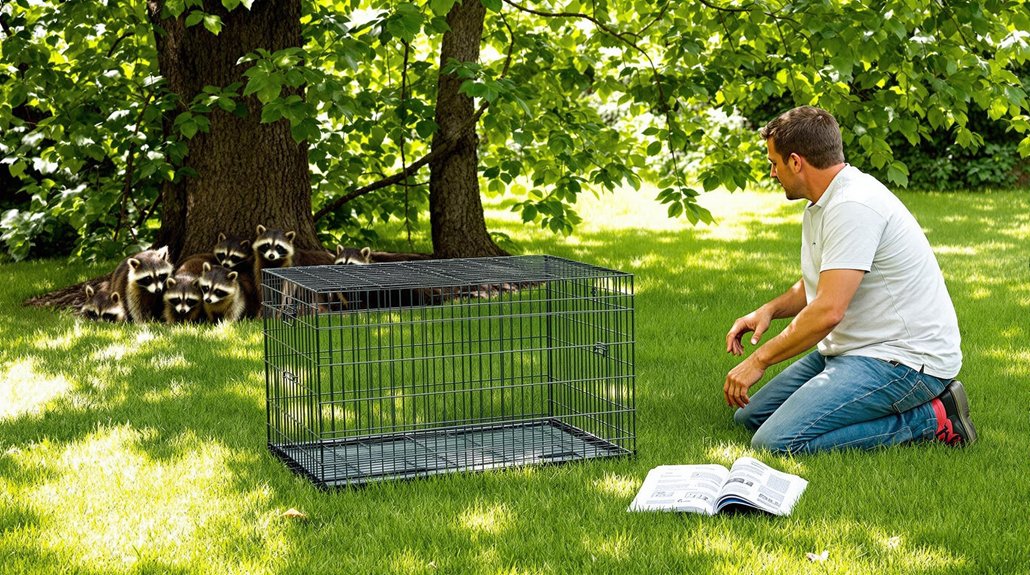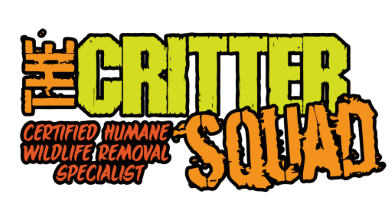Wildlife control is often misunderstood as just trapping and removing animals, but that’s not the whole story. Many believe all methods are harmful, but professionals use humane techniques that promote coexistence. Relocation isn’t always safe for animals, and it can disrupt ecosystems. Plus, some think wildlife control is only for cities, when rural areas face their own challenges. DIY solutions can be ineffective, and not all wildlife is dangerous. There’s more to learn about the ethics and methods in wildlife control.
Key Article Highlights
- Many people mistakenly believe wildlife control is solely about killing animals, ignoring humane methods that prioritize animal welfare and coexistence.
- Wildlife control professionals utilize exclusion techniques to prevent animal entry without harm, focusing on ethical solutions.
- Relocation is often misunderstood; it can stress animals and disrupt local ecosystems, making it a less desirable option.
- DIY wildlife control methods frequently fail and can cause more issues, highlighting the importance of hiring trained professionals.
- Understanding wildlife and their behaviors fosters appreciation and reduces fear, promoting a harmonious relationship between humans and animals.
Wildlife Control Is Just About Trapping and Relocating
Many people think that wildlife control only involves trapping and relocating animals, but this idea is misleading. Wildlife control is about much more than just trapping techniques. It involves understanding the animals and their behaviors. Effective wildlife control looks at long-term solutions, not just quick fixes. Relocation ethics play a huge role too. Simply moving an animal can disrupt its life and the local ecosystem. Animals are best left in their natural habitats, where they know how to survive. Instead of just trapping, experts may suggest ways to prevent wildlife from entering homes or properties. This approach respects the freedom of animals while keeping people safe. Proper bat exclusion methods ensure that animals are kept out of homes without harm. Understanding all aspects of wildlife control leads to better outcomes for everyone involved. Recognizing the importance of animal behavior can significantly improve the success of exclusion and prevention efforts. Additionally, having knowledge of humane raccoon trapping techniques can make a significant difference in how effectively animals are managed.
All Wildlife Control Methods Are Harmful
Some people believe that all wildlife control methods are harmful to animals. This idea is a misconception. Not all methods are cruel or damaging. Many wildlife control experts use humane methods that respect animal welfare. These approaches aim to prevent harm while addressing the issues caused by wildlife. Ethical considerations play a big role in how these methods are developed and applied. For example, exclusion techniques can keep animals out of homes without causing them distress. Additionally, some strategies focus on education, helping people coexist peacefully with wildlife. Understanding that there are humane options available can change the way people view wildlife control. Proper rodent removal techniques, such as trapping and exclusion, exemplify humane and effective wildlife management. Employing humane wildlife removal methods ensures that animals are treated ethically throughout the process. Recognizing the importance of animal welfare can promote more compassionate approaches to wildlife control.
Animals Can Always Be Relocated Safely
Relocating animals might seem like a simple solution, but it is not always safe or effective. Many people overlook the relocation challenges involved. For starters, animals often have a strong attachment to their home territory. When moved, they can struggle to adapt to a new environment. This can lead to stress and even death.
There are also ethical considerations to think about. Relocating animals may disrupt local ecosystems and harm other wildlife. Some species may not survive in unfamiliar areas, while others might become a nuisance in new locations. Instead of assuming relocation is the answer, it’s essential to explore other wildlife control methods that guarantee both animal welfare and ecological balance. Understanding raccoons can help in managing their presence responsibly and effectively. Freedom for all creatures should be respected, but it must be done wisely.
Wildlife Control Is Only Necessary in Urban Areas

Many people think wildlife control is only needed in cities. However, animals can also invade rural areas, especially when their natural habitats are disturbed. This can lead to conflicts and problems for people living outside urban settings.
Rural Wildlife Encroachment
While it might be easy to assume that wildlife control is only needed in urban areas, rural settings face their own unique challenges. In fact, rural habitats often see a range of wildlife interactions that can lead to issues. Animals like deer, raccoons, and coyotes might venture onto farms or homes, causing damage or posing risks to pets and livestock. This encroachment can disrupt daily life and lead to conflicts that require management. Additionally, many rural residents may not recognize the signs of problematic wildlife until it’s too late. Understanding the need for wildlife control in these areas is essential for maintaining harmony between people and nature, ensuring that everyone can enjoy their space freely and safely.
Natural Habitat Disruption
Wildlife control is often seen as an issue that only affects cities, but this view overlooks the broader impact of natural habitat disruption. In reality, wildlife struggles in both urban and rural settings due to habitat loss. Here are three key points to reflect upon:
- Habitat Preservation: Without proper control, species can overpopulate, leading to habitat destruction and loss of biodiversity.
- Ecological Balance: Disruptions can upset the natural order, harming predator-prey relationships and overall ecosystem health.
- Community Impact: Wildlife encroachment can affect local agriculture, property, and safety, showing that wildlife control isn’t just an urban concern.
Understanding these factors helps everyone appreciate the need for effective wildlife management, promoting both freedom and responsibility in maintaining our natural spaces.
DIY Solutions Are Always Effective

Many people think that DIY solutions will always work for wildlife control. However, these methods can often be ineffective or even dangerous. It’s important to evaluate the risks involved before trying to handle wildlife issues on your own.
Risk of Ineffective Methods
Though it might seem tempting to tackle wildlife issues with DIY solutions, the risk of using ineffective methods is significant. Many people underestimate how temporary solutions can lead to bigger problems down the line. Here are a few common pitfalls:
- Ineffective Deterrents: Homemade traps and sprays often fail, making the problem worse.
- False Security: Believing a quick fix will solve the issue can lead to complacency, allowing wildlife to return.
- Wasted Resources: Time and money spent on ineffective methods could be better used on professional help.
In the end, relying on DIY fixes might offer short-lived relief, but it often leaves homeowners in a more challenging position. Seeking expert assistance can lead to more permanent solutions.
Safety Concerns and Hazards
Using DIY solutions for wildlife control can come with significant safety concerns and hazards. Many people jump into these projects without proper safety protocols in place. This can lead to accidents, such as bites or scratches from cornered animals. Additionally, using traps or poisons without understanding their risks can be dangerous. Hazard awareness is vital when dealing with wildlife. Not knowing how to handle an animal correctly can put everyone at risk, including pets and children. Instead of relying solely on DIY methods, it’s wise to reflect on calling professionals who understand the right techniques and safety measures. In the end, protecting oneself and others is far more important than the desire for freedom in tackling wildlife issues alone.
All Wildlife Is Dangerous and Needs to Be Removed
While some people believe that all wildlife poses a danger and should be removed, this view overlooks the significant role many animals play in the ecosystem. Understanding animal behavior through wildlife education is essential for peaceful coexistence. Here are three reasons why not all wildlife is dangerous:
- Pollinators: Bees and butterflies help plants grow, which benefits the whole environment.
- Pest Control: Animals like owls and snakes keep the rodent population in check, reducing crop damage.
- Biodiversity: Every species contributes to a balanced ecosystem, which is crucial for human survival.
Instead of fearing all wildlife, it’s better to learn about them and appreciate their role in nature. Embracing this knowledge can lead to a more harmonious relationship with the animal world.
Wildlife Control Professionals Are Just Animal Killers
Many people believe that wildlife control professionals are simply animal killers, but this view misses the bigger picture. These experts often use humane methods to manage wildlife populations. They prioritize ethical considerations to guarantee animals are treated with respect. Their goal is to solve problems while keeping wildlife safe.
| Method | Description | Outcome |
|---|---|---|
| Exclusion | Sealing entry points | Prevents future issues |
| Relocation | Moving animals safely | Maintains ecosystem balance |
| Habitat Modification | Altering surroundings | Reduces human-wildlife conflict |
Wildlife control professionals aim for peaceful coexistence. They work to protect both humans and animals, working for solutions that respect nature and promote freedom for all living beings.
Frequently Asked Questions
What Types of Wildlife Are Most Commonly Controlled?
Many people often seek squirrel control and raccoon removal services. Squirrels can damage homes, while raccoons may rummage through trash. These animals frequently cause problems, leading homeowners to find effective solutions for wildlife management.
Are There Humane Methods for Managing Wildlife Conflicts?
Studies show that humane traps can reduce wildlife conflicts by 70%. Many people prefer humane methods, such as relocation methods, to manage these situations, ensuring both safety for humans and a chance for wildlife to thrive.
How Can I Prevent Wildlife From Entering My Home?
To prevent wildlife from entering a home, focus on exterior maintenance by sealing gaps and cracks. Proper food storage also helps, keeping all food sealed tight to avoid attracting unwanted animals. Stay vigilant and proactive.
What Should I Do if I Encounter a Wild Animal?
When faced with a wild animal, think of a cautious dance. Understanding wild animal behavior is key. Stay calm, back away slowly, and let nature be. Safe encounters allow both humans and animals to coexist peacefully.
How Do I Know When to Call a Wildlife Control Professional?
Knowing when to call a wildlife control professional depends on spotting wildlife signs, like tracks or droppings. A professional assessment can help determine if there’s a problem that needs to be addressed for safety and peace.

